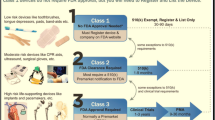Abstract
Remote patient management utilizing the Internet is a milestone in the management of patients with an implantable cardiac device. Pacemakers and implantable cardioverter–defibrillators (ICDs) store diagnostic information about device and lead integrity, the occurrence of atrial and ventricular arrhythmias, and parameters that may reflect on a patient’s heart failure status. Previously, these data could only be retrieved with a programmer at an in-person office visit. The introduction of remote follow-up and monitoring has changed the paradigm for the management of patients with implanted devices. Remote follow-up has been shown to be superior to traditional transtelephonic monitoring for the detection of clinically actionable events in pacemaker patients. Remote monitoring using ICDs with wireless technology has been demonstrated to result in detection of lead malfunction and atrial and ventricular arrhythmias while reducing the need for in-office evaluations without compromising patient safety. Studies are underway to evaluate the clinical utility of identification of atrial high-rate episodes and to identify patients at risk for exacerbation of heart failure. Remote monitoring technology has yet to be universally adopted by patients or physicians. Impediments to the implementation of remote monitoring including issues related to work flow and data management are explored.







Similar content being viewed by others
References
Furman, S., Parker, B., & Escher, D. J. (1971). Trans-telephone pacemaker clinic. The Journal of Thoracic and Cardiovascular Surgery, 61, 827–834.
Federico, A. J., Giori, F., Bhayana, J. N., Chardack, W. M., & Michalek, S. (1979). Instrumentation for the follow-up of pacemaker patients: Telephone transmission of the electrocardiogram and self-check by the patient on pacemaker function and capture. Pacing and Clinical Electrophysiology, 2, 315–324.
Dreifus, L. S., Zinberg, A., Hurzeler, P., Puziak, A. D., Pennock, R., Feldman, M., et al. (1986). Transtelephonic monitoring of 25,919 implanted pacemakers. Pacing and Clinical Electrophysiology, 9, 371–378.
Crossley, G. H., Chen, J., Choucair, W., Cohen, T. J., Gohn, D. C., Johnson, W. B., et al. (2009). Clinical benefits of remote versus transtelephonic monitoring of implanted pacemakers. Journal of the American College of Cardiology, 54, 2012–2019.
Varma, N., Epstein, A. E., Irimpen, A., Schweikert, R., Love, C., & For the TRUST investigators. (2010). Efficavy and safety of automatic remote monitoring for implantable cardioverter-defibrillator follow-up: The Lumos-T safely reduces routine office device follow-up (TRUST) trial. Circulation, 122, 325–332.
Varma, N., Michalski, J., Epstein, A. E., & Schweikert, E. (2010). Automatic remote monitoring of implantable cardioconverter-defibrillator lead and generator performance: The Lumos-T Safely RedUceS RouTine Office Device Follow-Up (TRUST) trial. Circulation, Arrhythmia and Electrophysiology, 3(5), 428–436.
Medtronic http://www.medtronic.com/product-advisories/physician/sprint-fidelis/6949-LEAD-PERFORMANCE. Accessed 15 Jan 2011.
Crossley, G., Boyle, A., Vitense, H., Sherfesee, L., & Mead, R. H. (2008). Trial design of the clinical evaluation of remote notification to reduce time to clinical decision: The clinical evaluation of remote notification to reduce time to clinical decision (CONNECT) study. American Heart Journal, 156, 840–846.
Crossley, G.H. (2010) The clinical evaluation of remote notification to reduce time to clinical decision (CONNECT) trial: The value of remote monitoring. Journal of the American College of Cardiology, (in press)
Glotzer, T. V., Hellkamp, A. S., Zimmerman, J., Sweeney, M. O., Yee, R., Marinchak, R., et al. (2003). Circulation, 107, 1614–1619.
Glotzer, T. V., Daoud, E. G., Wyse, D. G., Singer, D. E., Ezekowitz, M. D., Hilker, C., et al. (2009). The relationship between daily atrial tachyarrhythmia burden from implantable device diagnostics and stroke risk: The TRENDS study. Circulation, Arrhythmia and Electrophysiology, 2, 474–480.
Ip, J., Waldo, A. L., Lip, G. Y., Rothwell, P. M., Martin, D. T., Bersohn, M. M., et al. (2009). Multicenter randomized study of anticoagulation guided by remote rhythm monitoring in patients with implantable cardioverter-defibrillator and CRT-D devices: Rationale, design, and clinical characteristics of the initially enrolled cohort (The IMPACT study). American Heart Journal, 158, 364–370.
Connolly, S. J., Ezekowitz, M. D., Yusuf, S., Eikelboom, J., Oldgren, J., Parekh, A., et al. (2009). Dabigatran versus warfarin in patients with atrial fibrillation. The New England Journal of Medicine, 361, 1139–1151.
Saxon, L. A., Boehmer, J. P., Neuman, S., & Mullin, C. M. (2007). Remote active monitoring in patients with heart failure (RAPID-HF): Design and rationale. Journal of Cardiac Failure, 12, 241–246.
Yu, C. M., Wang, L., Chau, E., Chan, R. H. W., Kong, S. L., Tang, M. O., et al. (2005). Intrathoracic impedance monitoring in patients with heart failure: Correlation with fluid status and feasibility of early warning preceding hospitalization. Circulation, 112, 841–848.
Ritzema, J., Melton, I. C., Richards, A. M., Crozier, I. G., Frampton, C., Doughtly, R. N., et al. (2007). Circulation, 116, 2952–2959.
Jhanjee, R., Templeton, G. A., Sattiraju, S., Nguyen, J., Sakaguchi, S., Lu, F., et al. (2009). Relationship of paroxysmal atrial tachyarrhythmias to volume overload: Assessment by implanted transpulmonary impedance monitoring. Circulation, Arrhythmia and Electrophysiology, 2, 488–494.
Disclosures
Colin Movsowitz, MD is a consultant for Ambucor, a consultant and speaker for Biotronik and Boston Scientific, and a speaker for Medtronic and St. Jude Medical. Suneet Mittal, MD is a consultant for and EP fellowship training grant recipient from Biotronik, Boston Scientific, Medtronic and St. Jude Medical, and a speaker for Boston Scientific and Medtronic.
Both authors had full control of all primary data; we agree to allow the journal to review all data upon request.
Author information
Authors and Affiliations
Corresponding author
Rights and permissions
About this article
Cite this article
Movsowitz, C., Mittal, S. Remote patient management using implantable devices. J Interv Card Electrophysiol 31, 81–90 (2011). https://doi.org/10.1007/s10840-011-9548-2
Received:
Accepted:
Published:
Issue Date:
DOI: https://doi.org/10.1007/s10840-011-9548-2




